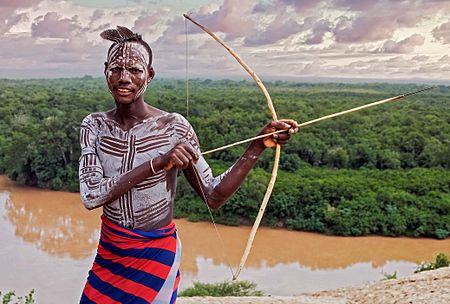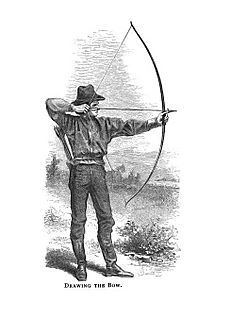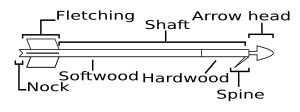Bow (weapon) facts for kids
A bow and arrow is a ranged weapon system. It uses a flexible stick (the bow) to shoot long, thin sticks (arrows). People used bows and arrows for hunting and fighting long before history was written down. They were very important weapons of war from ancient times until guns became common. Today, bows and arrows are mostly used for hunting and sports.
Archery is the skill of using bows to shoot arrows. A person who shoots arrows is called an archer. Someone who makes bows is a bowyer. A person who makes arrows is a fletcher.
Contents
How a Bow and Arrow Works
A bow has a flexible, curved part (the limbs) and a strong bowstring connecting their ends. An arrow is a long stick with a sharp tip and feathers (fletching) at the back. It also has a small notch (nock) to fit the bowstring.
To shoot, an archer places the arrow's nock on the bowstring. They hold the bow in one hand. With the other hand, they pull back the arrow and bowstring. This bends the bow's limbs, storing energy.
The archer then aims, often by looking along the arrow. When they let go of the string, the stored energy pushes the arrow forward very fast. A bag for carrying extra arrows is called a quiver.
When not in use, bows are usually "unstrung." This means one or both ends of the bowstring are taken off the bow. This helps the bow stay strong and elastic. Putting the string back on is called "stringing" the bow.
History of Bows and Arrows
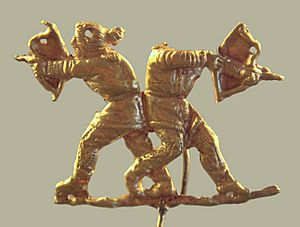
The oldest signs of bows and arrows come from South Africa. Arrowheads found there are about 72,000 to 60,000 years old. The earliest arrowheads found outside Africa were in Sri Lanka. They are about 48,000 years old. People there likely hunted monkeys and small animals with them.
In Europe, bow and arrow parts have been found from about 17,500 years ago in Germany. In Switzerland, flint pieces found in a bear's bones suggest arrows were used 13,500 years ago. In Kenya, stone-tipped arrows were used as weapons about 10,000 years ago.
The oldest complete bows are the elm Holmegaard bows from Denmark. They are about 9,000 years old.
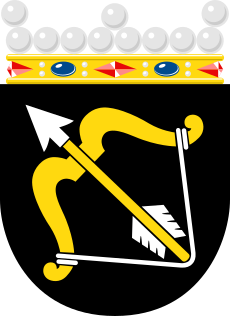
The bow was a key weapon for hunting and warfare for a long time. It was used until gunpowder weapons became common around the 16th century. In England, the longbow was a main weapon during the Middle Ages. Genghis Khan and his Mongol hordes used short bows to conquer large areas. Native Americans also used archery for hunting and defense.
Organized bow warfare ended in Western Europe by the mid-1600s. But it continued in some Eastern cultures and the New World until the 1800s. In the Canadian Arctic, bows were used for hunting caribou until the late 1900s.
Archery became a sport again in the late 1700s in Britain. Sir Ashton Lever started the Toxophilite Society in London in 1781.
How Bows are Made
Parts of the Bow
A modern bow has two curved, flexible limbs. These are usually made of wood. They are joined by a central part called the riser. Some bows, like the English longbow, are made from a single piece of wood. The ends of the limbs are connected by the bow string.
When an archer pulls the string back, the limbs bend. This stores energy. The amount of force needed to pull the string back is called the "draw weight." A higher draw weight means a more powerful bow. This bow can shoot heavier arrows faster or the same arrow even faster.
The top part of the bow is the upper limb, and the bottom is the lower limb. Each limb has a nock at its tip to hold the bowstring. The riser has the grip, where the archer holds the bow. It also has an arrow rest, a small shelf where the arrow sits. The bow window is the part of the riser above the grip.
Some bows, called composite bows, use different materials together. For example, they might use wood, animal horn, and sinew (animal tissue). Modern bows use materials like fiberglass, metals, and carbon fiber.
Arrows
An arrow usually has a shaft, an arrowhead at the front, and fletchings (feathers) and a nock at the back. Today, arrows are often made from carbon fiber, aluminum, fiberglass, or wood. Carbon arrows are light and don't bend, but they can be expensive. Aluminum arrows are cheaper but can bend. Wood arrows are the least expensive option but often will not be identical in weight and size to each other and break more often than the other types of shafts. Arrow sizes vary a lot. Most modern arrows are about 22 to 30 inches (56 to 76 cm) long.
There are different types of arrows. Target arrows are used for shooting at targets. They usually have simple arrowheads.
It's important never to shoot a bow without an arrow. If you do, the energy goes back into the bow, which can damage it.
Arrowheads
The arrowhead is the part of the arrow that hits the target. In the past, arrowheads were made from flint, bone, horn, or metal. Today, most are made of steel.
Common types of arrowheads include:
- Bodkin points: Simple metal spikes designed to pierce armor.
- Broadheads: Usually triangular or leaf-shaped with sharp edges. These are often used for hunting.
- Piles: Simple metal cones, either sharp or blunt. They are mainly used for target shooting.
Other types include blunt heads for hunting small game or birds. Barbed heads were used in warfare or hunting to make arrows harder to remove.
Bowstrings
Bowstrings often have a marked spot called the nocking point. This shows where the arrow should be placed. The area around the nocking point is often wrapped with thread to protect it from wear. This is called the serving.
One end of the bowstring has a permanent loop. The other end has an adjustable loop made with a knot. This knot can be changed to make the string longer or shorter.
Historically, bowstrings were made from flax, silk, hemp, animal guts, sinews, or rawhide. Modern bowstrings use strong fibers like Dacron or Kevlar. Some Compound bows use steel wires. Nylon is not good for bowstrings because it stretches too much.
Types of Bows
Bows can be described in many ways. This includes the materials they are made from, how long they can be drawn, and their shape.
Here are some common types:
By Side Profile
- Recurve bow: The tips of this bow curve away from the archer. When the bow is drawn, these curves straighten. When the arrow is released, the tips snap back, adding extra speed to the arrow.
- Reflex bow: The entire limbs of this bow curve away from the archer when it's not strung. This curve is opposite to how the bow bends when drawn.
By Material
- Self bow: A bow made from a single piece of wood.
- Composite bow: A bow made from more than one type of material, like wood, horn, and sinew.
By Limb Shape
- Longbow: A self bow with rounded limbs. It's usually about the same height as the archer, often over 5 feet (1.5 meters) long. The traditional English longbow was made of yew wood.
- Flatbow: This bow has limbs that are mostly rectangular in shape. Many Native American groups traditionally used flatbows.
Other Types
- Takedown bow: A bow that can be taken apart for easy carrying. It usually has two limbs and a riser that separate.
- Compound bow: This bow uses a system of pulleys (called cams) at the ends of the limbs. These cams help the archer draw the string and make it easier to hold the bow at full draw. Compound bows often have high draw weights.
- Crossbow: A bow mounted horizontally on a frame, similar to a gun stock. It has a lock to hold the string at full draw. Crossbows usually shoot short, thick arrows called bolts or "quarrels."
- Footbow: A bow designed to be used with both the legs and arms while lying down. This type of bow has been used to set records for the furthest arrow shot.
See also
 In Spanish: Arco y flecha para niños
In Spanish: Arco y flecha para niños


